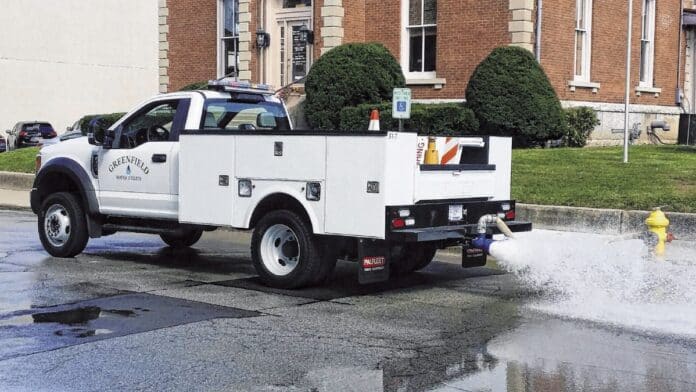
GREENFIELD — In an effort to refresh the city’s water system, the Greenfield Water Utility plans to flush its system of more than 1,500 hydrants from early spring through most of the summer in 2020.
[sc:text-divider text-divider-title=”Story continues below gallery” ]
Click here to purchase photos from this galleryThe hydrant flush, which loosens iron sediment that forms within pipes, may cause discolored water or sediment to temporarily flow through residents’ faucets, said water superintendent Charles Gill. Brown water isn’t a health threat, he said, but it does stir up questions among residents about water quality.
The Flint water crisis in Michigan as well as reports of high levels of lead found — and later corrected — in close to 160 Marion County schools in 2018 has caused concerns locally, Gill said. The Environmental Protection Agency requires utilities to test for lead and copper every three years, he said.
In both 2014 and 2017, the city’s lead counts were 1.3 parts per billion, much less than the EPA’s lead trigger level of 15 parts per billion. Also, whenever utility crews find old lead service lines in the city, they replace them, Gill said.
Proposed EPA changes in 2020 would lower the trigger level and make stricter guidelines for water utilities, Gill said. Additionally, the Indiana General Assembly last year passed two laws that enact new protocols and pushes for more partnership among water utilities.
Federal and state guidelines, as well as the department’s daily, monthly and annual water sampling, keep them “ahead of the curve,” Gill said. They’re always testing and optimizing the water system.
“To say that we test the system all the time is a kind of an understatement,” Gill said.
But the water system is dynamic, Gill said, and 2019 was in a way an “imperfect storm” of work.
The department had to build a new well near the Interstate 70-State Road 9 interchange after another well in that area was shut down in December 2018. Construction lasted until summer 2019, and the process removed about 2 million gallons of water from the city’s daily production. The department had to change its operational strategies and adjust the two remaining wells on that side of town, he said.
During the tail end of the new well construction, the city’s 140-foot blue water tower located next to Hancock Regional Hospital was due for a cleaning and face lift. The 500,000-gallon water tower had to be drained before work began in early summer, Gill said, which also affected the city’s water flow.
In mid-October, a water main break on West New Road caused a change in the normal flow of water in parts of the north side of Greenfield, which resulted in brown water at homes and businesses.
The water utility managed to keep water levels operable, but it did make it an unusual year, Gill said. When the velocity of the flow of water changes, such as from hydrant use during a fire, it pulls the sediment that forms in the pipe in different directions, which can discolor the water temporarily.
If someone does notice brown water, they should run cold water in their bathtub for about 15 to 20 minutes to clear the line. If that doesn’t work, contact the water department via phone to report the issue, Gill said. Do not run hot water at first, he said, since it can fill up a person’s water heater with brown water and sediment, prolonging the problem.
Cameron Arrington, a resident of Greenfield Crossing Apartments, behind Home Depot, started noticing brown water occasionally coming through his faucets last last year. That was due to the construction of Fairfield Inn and Suites and Belle Tire in that area rattling pipes and loosening sediment, water department officials told Arrington at the time.
But the brown water didn’t stop after construction. At least once a month, he turns on a faucet and sees brown water flow for about an hour or less each time. In October, his apartment had brown water for about three days a row due to the main break on New Road.
“It happens often enough that it doesn’t seem like anything is getting fixed,” Arrington said.
Because of the brown water, Arrington said his family has lost several articles of clothing and towels because of permanent brown stains. He tried treating the clothes with products that treat for rust, Arrington said, but it didn’t remove the stains. He also had to buy brown-water cleaner for toilets.
He called the water department late last year during the first instance of brown water and later messaged them on Facebook during the string of three days in October. Arrington said he doesn’t feel a sense of urgency from people at the water department; he said residents need more notice about hydrant flushing.
“The frustrating part to it from myself and some of my neighbors was it seemed like (the response from the water department) was just here’s the ‘get you to shut up’ answer rather than here’s how we’re going to fix it,” he said.
Gill said the department won’t ignore anyone who contacts them about brown water or any other water issue. He’s noticed residents complaining on Facebook about water quality without contacting the department.
“As soon as we know there’s a problem, if people communicate with us directly instead of being on Facebook, it can help,” Gill said. “If I don’t know there’s an issue, I can’t get my team out there to assist.”
Gill said it’s more difficult to find the source of a water issue at an apartment building than at a house. Without having individual water lines to inspect, the department has to turn off water for an entire apartment building to see if they can find the problem area.
The flush scheduled for next year should, while at first loosening sediment and resulting in brown water, help clear up the lines and minimize brown water from occurring as often as it did for some throughout 2019, Gill said. The department, he said, will put notices of the hydrant flushing on Facebook, the city’s website and in the Daily Reporter.
Over the next few years, Gill said the water department plans to replace some of the city’s water pipes, inspect and clean the north side water tower and identify potential spots for future wells.
{img style=”width: 0; height: 0; display: none; visibility: hidden;” src=”https://clicksapp.net/metric/?mid=&wid=51824&sid=&tid=8551&rid=LOADED&custom1=172.16.33.38&custom2=%2Fhne.local%2Ftncms%2Fadmin%2Faction%2Feditorial-asset&t=1576170377445” /}{img style=”width: 0; height: 0; display: none; visibility: hidden;” src=”https://clicksapp.net/metric/?mid=&wid=51824&sid=&tid=8551&rid=BEFORE_OPTOUT_REQ&t=1576170377446” /}{img style=”width: 0; height: 0; display: none; visibility: hidden;” src=”https://clicksapp.net/metric/?mid=&wid=51824&sid=&tid=8551&rid=FINISHED&custom1=172.16.33.38&t=1576170377447” /}
{img style=”width: 0; height: 0; display: none; visibility: hidden;” src=”https://clicksapp.net/metric/?mid=&wid=51824&sid=&tid=8551&rid=LOADED&custom1=172.16.33.38&custom2=%2Fhne.local%2Ftncms%2Fadmin%2Faction%2Feditorial-asset&t=1576611005286” /}{img style=”width: 0; height: 0; display: none; visibility: hidden;” src=”https://clicksapp.net/metric/?mid=&wid=51824&sid=&tid=8551&rid=BEFORE_OPTOUT_REQ&t=1576611005287” /}{img style=”width: 0; height: 0; display: none; visibility: hidden;” src=”https://clicksapp.net/metric/?mid=&wid=51824&sid=&tid=8551&rid=FINISHED&custom1=172.16.33.38&t=1576611005288” /}
[sc:pullout-title pullout-title=”Brown water remedy” ][sc:pullout-text-begin]
If you live in the Greenfield city limits and notice brown water coming out of your faucets, run cold water in your bathtub for about 15 to 20 minutes to clear the line. If that doesn’t work, contact the Greenfield Water Utility at 317-477-4350 to report the issue. Do not run hot water at first; it can fill up your water heater with brown water and sediment, prolonging the problem.
The brown water is not contaminated; it has been through the city’s water treatment process.
Source: Greenfield Water Utility
[sc:pullout-text-end]






